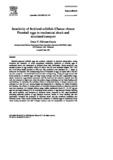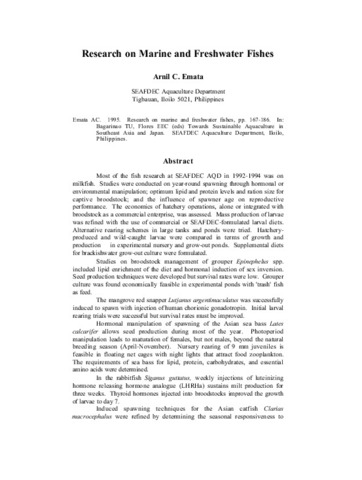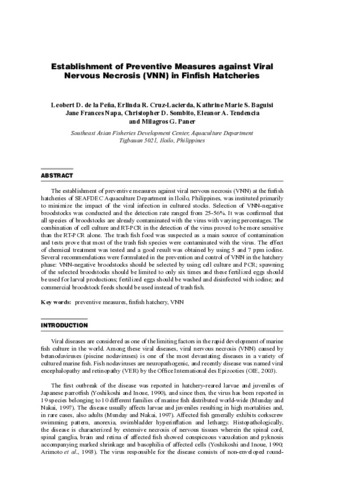Sensitivity of fertilized milkfish (Chanos chanos Forsskal) eggs to mechanical shock and simulated transport
- Global styles
- MLA
- Vancouver
- Elsevier - Harvard
- APA
- Help

閲覧/開く
日付
1998Page views
2,266ASFA keyword
AGROVOC keyword
Taxonomic term
Metadata
アイテムの詳細レコードを表示する
Share
抄録
Naturally-spawned milkfish eggs are routinely subjected to physical manipulation during collection and transport. To avoid unnecessary mortalities, sensitivity of milkfish eggs to mechanical shock was determined at different times after fertilization. Shock sensitivity was assessed in terms of egg mortality within 8 h after a free fall over calibrated heights. The LD50 and LD10 (drop height resulting in 50% and 10% mortality) were estimated for 11 stages of embryonic development. The corresponding force (F) imparted to eggs on impact after a free fall was also computed. LD10 estimates (cm) and their corresponding F (erg per egg) showed that shock sensitivity of milkfish eggs was high during cleavage until the early segmentation stage, rapidly declined as segmentation proceeded until the head and tail started to separate from the yolk, but returned to high levels when the embryo begun twitching and the heart beating until near-hatching. To determine the sublethal effects of mechanical shock, C-shaped embryos were subjected to a free fall over varying heights and transported to a hatchery for further incubation and hatching. The effects of varying periods of simulated transport (mobile or stationary periods) were also examined. At C-shaped embryo stage, neither mechanical shock (F, 13–127 erg per egg) nor prolonged shaking (3–9 h) simulating mobile periods of egg transport affected hatching rate, larval mortality, and incidence of deformed larvae. Exposure to still water (unshaken) simulating stationary periods of egg transport, however, tended to lower hatching rate and significantly increased the incidence of deformed larvae and the combined mortalities and deformed larvae. These results indicate that the sensitivity of milkfish eggs to mechanical shock varies during incubation and that C-shaped embryos may be manipulated or transported with minimum risk of injury. Some recommendations are given regarding proper handling and transport of fertilized eggs.
Suggested Citation
Hilomen-Garcia, G. V. (1998). Sensitivity of fertilized milkfish (Chanos chanos Forsskal) eggs to mechanical shock and simulated transport. Aquaculture , 159(3–4), 239-247. https://doi.org/10.1016/S0044-8486(97)00235-4
Type
ArticleISSN
0044-8486Collections
- Journal Articles [1258]
Related items
Showing items related by title, author, creator and subject.
-
Research on marine and freshwater fishes
Emata, Arnil C. (Aquaculture Department, Southeast Asian Fisheries Development Center, 1995)Most of the fish research at SEAFDEC AQD in 1992-1994 was on milkfish. Studies were conducted on year-round spawning through hormonal or environmental manipulation; optimum lipid and protein levels and ration size for ... -
The sulfide tolerance of milkfish and tilapia in relation to fish kills in farms and natural waters in the Philippines
Fish kills of milkfish Chanos chanos and tilapia Oreochromis spp. now occur frequently in brackish, marine, and freshwater farms (ponds, pens, and cages) in the Philippines. Aquafarms with high organic load, limited water ... -
Establishment of preventive measures against viral nervous necrosis (VNN) in finfish hatcheries
de la Peña, Leobert D.; Cruz-Lacierda, Erlinda R.; Baguisi, Kathrine Marie S.; Napa, Jane Frances; Sombito, Christopher D.; Tendencia, Eleonor ; Paner, Milagros G. (Aquaculture Department, Southeast Asian Fisheries Development Center, 2005-03)
The establishment of preventive measures against viral nervous necrosis (VNN) at the finfish hatcheries of SEAFDEC Aquaculture Department in Iloilo, Philippines, was instituted primarily to minimize the impact of the viral ...
; Paner, Milagros G. (Aquaculture Department, Southeast Asian Fisheries Development Center, 2005-03)
The establishment of preventive measures against viral nervous necrosis (VNN) at the finfish hatcheries of SEAFDEC Aquaculture Department in Iloilo, Philippines, was instituted primarily to minimize the impact of the viral ...





